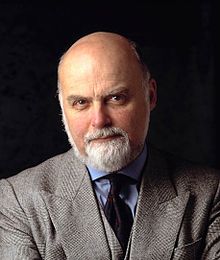Bruno Sacco
Bruno Sacco (born November 12, 1933 in Udine , Italy ) is a German-Italian car designer . From 1958 to 1999 he was a constructor, designer and stylist at Mercedes-Benz and was responsible for the design of numerous Mercedes-Benz cars .
Vita
After training in Tarvisio and Udine, he attended the Turin Polytechnic . During his studies at the design office Carrozzeria Ghia he gained his first experience in the field of body design and later took on smaller assignments both for her and for Pininfarina .
Career history
In 1958, Sacco began his career at Daimler-Benz. As a stylist and designer, he worked on various projects under the direction of Karl Wilfert , Friedrich Geiger and Béla Barényi , such as: E.g. on the Mercedes 600 and on the roadsters 230 SL, 250 SL and 280 SL of the W 113 series known as the "Pagoda" . He also took over the design project management for the safety exhibitions at the time and for the so-called “rolling test laboratories”, the experimental vehicles C111- I and C 111-II.
In 1970 he took over the management of the body construction and dimensional conception department. With his help, the ESF prototypes (experimental safety vehicle) and the W 123 series were created . From 1975, Sacco headed the main stylistics department as the successor to Friedrich Geiger. Since then it has shaped the appearance of Mercedes-Benz cars. The record-breaking diesel car C 111-III (1978) and the S-Class of the W 126 series (1979) with the Sacco boards named after him were created . In 1978 he took over the management of the stylistics department, and in 1987 the board appointed him director of the design department.
In 1993 Sacco became head of design and a member of the directors' group. In this capacity, he also took on a mandate function for the design of the products in the Commercial Vehicles division. In 1999, after 41 years in Mercedes-Benz design, he handed over the management of the division to Peter Pfeiffer .
Design philosophy

Sacco assumed a three to five year development time, an average production period of eight years and a service life of around 20 years. Consequently, the design of a Mercedes-Benz must remain current for almost 30 years, but at the same time also timeless. To ensure long-term success, Sacco developed a Mercedes-Benz design philosophy in the 1970s. A design family should be created to which every passenger car with the star belongs. The top priority was: A Mercedes-Benz must be intuitively recognized by the public in all cultures around the world as a family member. And when a Mercedes-Benz is further developed in the next model generation, the model series identity should be preserved. Sacco spoke of a "vertical affinity". It was considered a central theme of the Mercedes-Benz design philosophy and was intended to guarantee that the predecessor did not look out of date after the presentation of the new model generation.
The second mainstay of the Mercedes-Benz design philosophy was the brand identity. It required traditional design features to be maintained, further developed and presented side by side in all series. In this context, the term “horizontal homogeneity” was used. It found its expression, for example, in the design of the radiator grille, headlights and rear lights. Although the details were formally differentiated into limousines , coupés and roadsters , the viewer should immediately recognize their family affiliation.
Awards
During the years he worked for Daimler-Benz, Sacco received numerous awards:
- 1981: Honorary member of the "Academia Mexicana de Diseño"
- 1991: Awarded the title "Grande Ufficiale dell'Ordine al Merito della Repubblica Italiana"
- 1993: Presentation of the "Cover Award - Auto & Design", Turin
- 1993: Awarded the "Premio Mexico 1994" - Patronato Nacional de las Asociaciones de Diseño AC, Mexico
- 1994: Presentation of the "Apulia Award for Professional Achievement"
- 1996: "Best Designer" award from "Car" magazine
- 1996: “Designer's Designer” award from “Car” magazine
- 1997: Presentation of the "Lifetime Design Achievement Award", Detroit
- 1997: Received the "Raymond Loewy Designer Award" for the "Lucky Strike" brand
- 2002: Honorary doctorate from the University of Udine
- 2006: Admission to the " Automotive Hall of Fame ", Dearborn
- 2007: Admission to the “European Automotive Hall of Fame”, Geneva
Web links
- www.daimlerchrysler.com ( Memento from March 11, 2007 in the Internet Archive ) about Bruno Sacco
Individual evidence
- ↑ Mathias Kuhn: The automobile designer Bruno Sacco combines technical innovation with timeless beauty. In: Untertürkheimer Zeitung. October 7, 2004, accessed May 5, 2016 .
| personal data | |
|---|---|
| SURNAME | Sacco, Bruno |
| BRIEF DESCRIPTION | Italian constructor and designer (“stylist”) at Mercedes-Benz |
| DATE OF BIRTH | November 12, 1933 |
| PLACE OF BIRTH | Udine |
